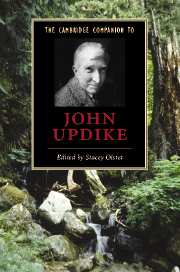Book contents
- Frontmatter
- Introduction: “A sort of helplessly 50’s guy”
- Part I Early influences and recurrent concerns
- Part II Controversy and difference
- 4 Updike, women, and mythologized sexuality
- 5 Updike, race, and the postcolonial project
- 6 Updike, ethnicity, and Jewish-American drag
- Part III American chronicles
- Conclusion: U(pdike) & P(ostmodernism)
- Select bibliography
- Index
6 - Updike, ethnicity, and Jewish-American drag
from Part II - Controversy and difference
Published online by Cambridge University Press: 28 August 2006
- Frontmatter
- Introduction: “A sort of helplessly 50’s guy”
- Part I Early influences and recurrent concerns
- Part II Controversy and difference
- 4 Updike, women, and mythologized sexuality
- 5 Updike, race, and the postcolonial project
- 6 Updike, ethnicity, and Jewish-American drag
- Part III American chronicles
- Conclusion: U(pdike) & P(ostmodernism)
- Select bibliography
- Index
Summary
I am surely not the only critic who has wondered how much of John Updike went into the making of the Rabbit books, his four-novel series about an average man - Harry “Rabbit” Angstrom - fighting against everything that militates against his self-styled “specialness,” and in much the same way, I am hardly the only critic who sees Updike peeking out from under Henry Bech's Jewish skin. Projection accounts for both characters. But to begin before Rabbit first appeared, one needs to meet Fred “Ace” Anderson, the protagonist of “Ace in the Hole,” one of Updike's earliest stories (published first in a 1955 issue of the New Yorker and then in his 1959 collection, The Same Door, 14-26). Ace is a former high school basketball star caught in the gears of adult responsibility: he has a wife, a child, and a dead-end job. His raw sexuality - one of the euphemisms signaled in Updike's pun-riddled title - may have tarnished a bit since his glory days, but as the story's last paragraphs make clear, Ace can still make his wife swoon by dancing her across the floor of their cramped apartment.
“Ace in the Hole” would be regarded as a minor Updike story if it were not for the similarities between Ace Anderson and the more fully developed Rabbit Angstrom. Both know deep in their bones that good looks and a smooth style will trump conventional behavior every time, and that other people will clean up your messes, and possibly even envy you for being daring enough to make them.
- Type
- Chapter
- Information
- The Cambridge Companion to John Updike , pp. 91 - 104Publisher: Cambridge University PressPrint publication year: 2006



